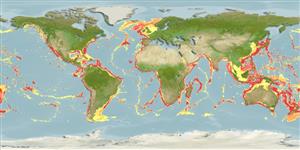Élasmobranches (requins et raies) (sharks and rays) >
Squaliformes (Sleeper and dogfish sharks) >
Somniosidae (Sleeper sharks)
Etymology: Zameus: zame, Japanese for shark (at the time, Z. squamulosus was known only from Japan). (See ETYFish); squamulosus: Latin for covered or beset with small scales, “so minute as to give a velvety appearance to the skin”. (See ETYFish).
More on author: Günther.
Environment: milieu / climate zone / depth range / distribution range
Écologie
marin benthopélagique; profondeur 0 - 2200 m (Ref. 6871), usually 400 - 900 m (Ref. 55584). Deep-water; 68°N - 56°S, 180°W - 180°E
Atlantic, Indian and Pacific tropical oceans.
Length at first maturity / Taille / Poids / Âge
Maturity: Lm ?, range 59 - ? cm
Max length : 84.0 cm TL mâle / non sexé; (Ref. 6871)
Épines dorsales (Total): 2; Rayons mous dorsaux (Total): 0; Épines anales 0; Rayons mous anaux: 0. Black in color, small dorsal fin spines, moderately long snout, small lanceolate teeth without cusplets in upper jaw and large high, knife-cusped cutting teeth in lower jaw, mouth moderately wide and nearly transverse, caudal fin with strong subterminal notch and short lower lobe (Ref. 247).
Demersal or pelagic near continental slopes and seamounts in depths of 550-2,000 m (Ref. 6871, 58302). Also found from the surface to 580 m over deep water (Ref. 26346). Ovoviviparous (Ref. 205). Used dried and salted for human consumption and for fishmeal (Ref. 6871). Caught rarely by longline fisheries operating in deepwater; also caught, but rarely landed, by pelagic tuna longline fisheries (Ref.58048).
Life cycle and mating behavior
Maturité | Reproduction | Frai | Œufs | Fécondité | Larves
Distinct pairing with embrace (Ref. 205). Presumambly viviparous, with yolk-sac dependancy (Ref.58048).
Compagno, L.J.V., 1984. FAO Species Catalogue. Vol. 4. Sharks of the world. An annotated and illustrated catalogue of shark species known to date. Part 1 - Hexanchiformes to Lamniformes. FAO Fish. Synop. 125(4/1):1-249. Rome, FAO. (Ref. 247)
Statut dans la liste rouge de l'IUCN (Ref. 130435)
Menace pour l'homme
Harmless
Utilisations par l'homme
Pêcheries: intérêt commercial mineur
Plus d'informations
RéférencesAquacultureProfil d'aquacultureSouchesGénétiqueElectrophoresesHéritabilitéPathologiesTraitementNutrientsMass conversion
CollaborateursImagesStamps, Coins Misc.SonsCiguateraVitesseType de nageSurface branchialeOtolithesCerveauxVision
Outils
Articles particuliers
Télécharger en XML
Sources Internet
Estimates based on models
Preferred temperature (Ref.
123201): 4.1 - 12.6, mean 7.7 °C (based on 948 cells).
Phylogenetic diversity index (Ref.
82804): PD
50 = 1.0000 [Uniqueness, from 0.5 = low to 2.0 = high].
Bayesian length-weight: a=0.00389 (0.00168 - 0.00901), b=3.13 (2.94 - 3.32), in cm total length, based on LWR estimates for this (Sub)family-body shape (Ref.
93245).
Niveau trophique (Ref.
69278): 4.0 ±0.60 se; based on food items.
Résilience (Ref.
120179): Faible, temps minimum de doublement de population : 4,5 à 14 années (Fec assumed to be <100).
Fishing Vulnerability (Ref.
59153): Moderate to high vulnerability (54 of 100).
Nutrients (Ref.
124155): Calcium = 5.01 [0.96, 26.10] mg/100g; Iron = 0.208 [0.047, 0.710] mg/100g; Protein = 18.7 [16.3, 21.1] %; Omega3 = 0.3 [0.1, 1.0] g/100g; Selenium = 20.2 [5.1, 67.9] μg/100g; VitaminA = 15.5 [2.9, 85.2] μg/100g; Zinc = 0.398 [0.181, 0.835] mg/100g (wet weight);
